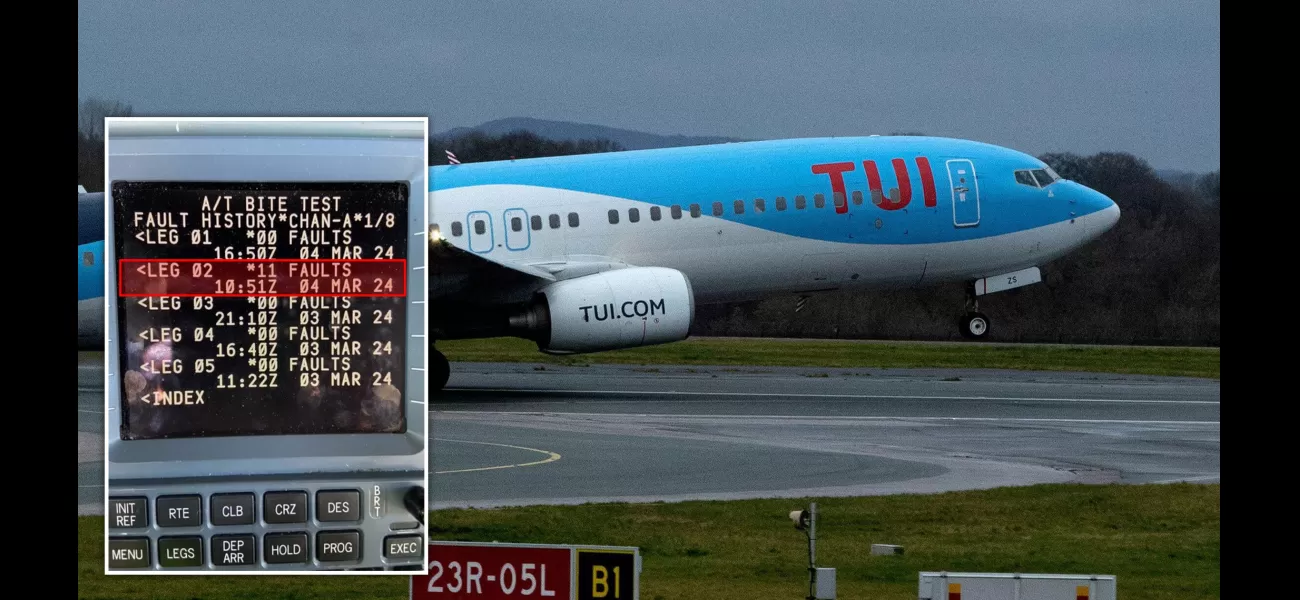A UK Boeing 737 flight was nearly in a deadly accident due to a malfunction in its software.
Plane almost didn't make it off Bristol Airport runway due to low power during takeoff.
June 7th 2024.

The plane was almost unable to take off due to a technical error that disrupted its power controls, according to a recent report. The incident occurred on March 4th when a Boeing 737-800 was departing Bristol Airport for a TUI flight to Gran Canaria with 163 passengers and nine crew members on board. It was a close call as the plane left the tarmac just three seconds before the end of the runway, with insufficient thrust to meet safety regulations. Fortunately, the plane did not encounter any further issues, but the situation was deemed serious by the Air Accidents Investigation Branch of the Department of Transport, who authored the report.
Upon investigation, it was discovered that there were 11 faults recorded on the plane's computer on the day of the incident. One of these faults involved the plane's autothrottle system, which is designed to automate fuel flow during different phases of the flight, including takeoff. However, in this case, the system disengaged when the crew selected takeoff mode, resulting in a 9% decrease in thrust levels. Unfortunately, the pilots failed to notice this and did not manually override the system.
Boeing has acknowledged that there have been past issues with the autothrottle system during takeoff, but they claim that these are usually resolved during subsequent functionality checks. However, in light of this incident, the manufacturer has recommended upgrading the autothrottle system on this and other affected planes.
The potential consequences of not taking off with enough thrust are severe, as it can cause the plane to stall and crash. While it is not clear if the thrust used in this particular incident was low enough to pose such a risk, it is a reminder of the importance of proper maintenance and thorough checks in ensuring the safety of passengers and crew.
The report also highlights the critical role of automation in modern aircraft and the potential risks that come with it. The autothrottle system is meant to remain engaged from takeoff to landing, but in this case, it was prematurely disengaged, possibly due to a software glitch. This incident serves as a reminder for pilots to always be vigilant and prepared to take over manual control in case of any technical errors.
TUI, the airline operating the flight, has reassured that they have cooperated with authorities and will take any necessary steps to ensure the safety of their passengers and crew. They believe that the lessons learned from this incident will also benefit the aviation sector as a whole.
In conclusion, this near-miss at takeoff serves as a wake-up call for the aviation industry to continuously review and improve safety measures to prevent similar incidents from happening in the future. The safety of passengers and crew should always remain the top priority in any flight operation.
Upon investigation, it was discovered that there were 11 faults recorded on the plane's computer on the day of the incident. One of these faults involved the plane's autothrottle system, which is designed to automate fuel flow during different phases of the flight, including takeoff. However, in this case, the system disengaged when the crew selected takeoff mode, resulting in a 9% decrease in thrust levels. Unfortunately, the pilots failed to notice this and did not manually override the system.
Boeing has acknowledged that there have been past issues with the autothrottle system during takeoff, but they claim that these are usually resolved during subsequent functionality checks. However, in light of this incident, the manufacturer has recommended upgrading the autothrottle system on this and other affected planes.
The potential consequences of not taking off with enough thrust are severe, as it can cause the plane to stall and crash. While it is not clear if the thrust used in this particular incident was low enough to pose such a risk, it is a reminder of the importance of proper maintenance and thorough checks in ensuring the safety of passengers and crew.
The report also highlights the critical role of automation in modern aircraft and the potential risks that come with it. The autothrottle system is meant to remain engaged from takeoff to landing, but in this case, it was prematurely disengaged, possibly due to a software glitch. This incident serves as a reminder for pilots to always be vigilant and prepared to take over manual control in case of any technical errors.
TUI, the airline operating the flight, has reassured that they have cooperated with authorities and will take any necessary steps to ensure the safety of their passengers and crew. They believe that the lessons learned from this incident will also benefit the aviation sector as a whole.
In conclusion, this near-miss at takeoff serves as a wake-up call for the aviation industry to continuously review and improve safety measures to prevent similar incidents from happening in the future. The safety of passengers and crew should always remain the top priority in any flight operation.
[This article has been trending online recently and has been generated with AI. Your feed is customized.]
[Generative AI is experimental.]
0
0
Submit Comment





